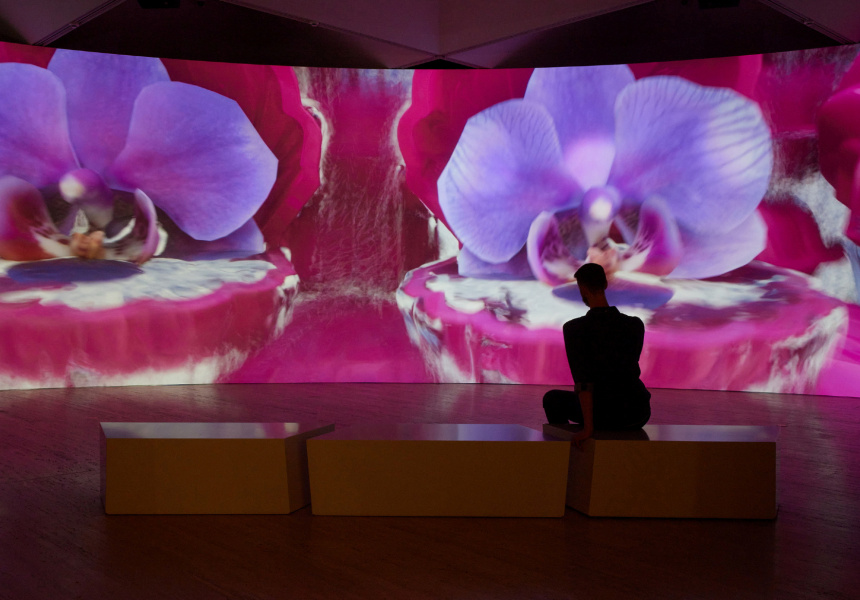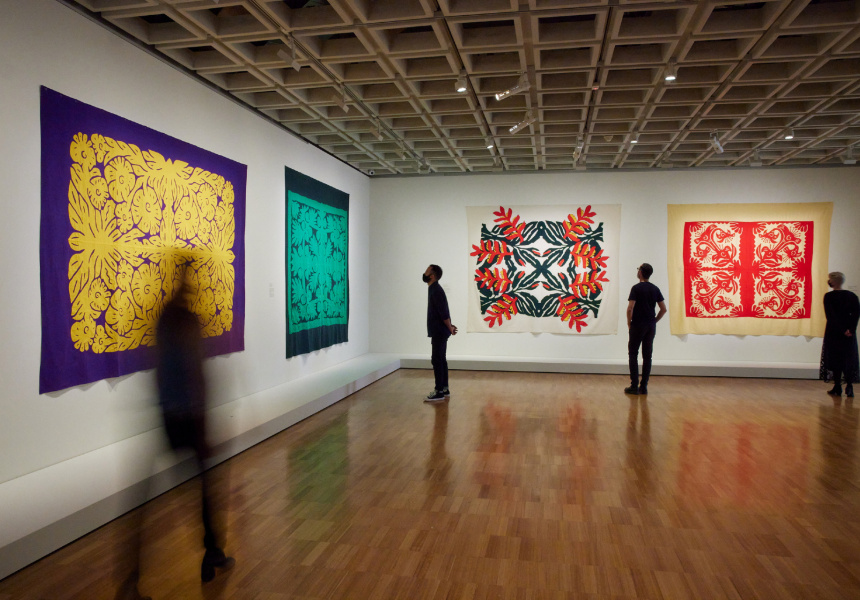23rd Biennale of Sydney
Titled Rivus, meaning “stream” in Latin, the 23rd Biennale of Sydney features works that engage with water ecology and relationships with the natural world. More than 330 artworks by 89 participants and 400 events appear in a program that promises to introduce new ideas and expand our understanding of the ways art and ecology can intersect.
Highlights include Flow, a 600-square-metre bamboo structure by Sydney multidisciplinary studio Cave Urban, suspended from the ceiling of The Cutaway at Barangaroo; The Great Animal Orchestra, a large-scale immersive soundscape of 15,000 animals recorded over 50 years by “soundscape ecologist” Bernie Krause; Venezuelan-born, Paris-based artist Milton Becerra’s large-scale work, Lost Paradise, which sees three stones suspended by a nexus of thread inside the Museum of Contemporary Art; a 365-million-year-old fish fossil from Canowindra in NSW being displayed to the public for the first time, as well as unique works in locations including Pier 2/3 at Walsh Bay Arts Precinct, the Arts and Cultural Exchange, National Art School and Art Gallery of NSW.
For fans of Sydney’s contemporary experimental music scene – and an evening drink – there’s also Art After Dark at Galleria Campari located inside the Cutaway at Barangaroo. Curated by Sydney musician and composer Megan Alice Clune in collaboration with projection artist Carla Zimbler, the 13-week program aims to showcase and highlight the diverse landscape of Sydney music and its surrounding communities. Performers across the duration of the festival include Alexandra Spence, Low Flung, Mara, Rydeen, Ilex, Del Lumanta, Wytchings, Loose-y Crunché, Efp, Gi, and MP Hopkins, as well as DJ sets from Chunyin and Bocconcini. Zimbler will provide a sensory array of projections to match proceedings.
Until June 13. Various locations. Sydney.
Matisse Alive at AGNSW
Matisse Alive – a free program of art, music, performance and community events – uses the AGNSW’s blockbuster Matisse: Life & Spirit exhibition as a springboard to explore the artistic legacy of Henri Matisse, 70 years after his death.
Four new artistic projects form the heart of the program. In Framily Ties, New York artist Nina Chanel Abney calls on Matisse’s signature cut-outs and his bold use of colour and shape to create a series of portraits that capture moments of domestic life.
Melbourne artist Sally Smart acknowledges the invaluable contribution Matisse’s female assistants made to his art – particularly in his years of ill health late in life – in The Artist’s House, a large-scale multimedia installation of collaged fabrics.
Local artist Angela Tiatia reflects on Matisse’s preoccupation with the Pacific Islands in The Pearl, a moving-image work created using computer software and artificial intelligence. The culture of the Pacific Islands is also the subject of Vaiola, a series of intricately patterned tapa, or bark cloth, works by New Zealand’s Robin White in collaboration with Tongan artist Ebonie Fifita.
Until April 3. John Kaldor Family Hall, Lower Level 2, Art Gallery of NSW.
David Malangi Daymirringu: Artist Room, MCA Collection at MCA
David Malangi Daymirringu is a name you should know. Born in 1927 at Mulanga, near the mouth of Glyde River in Central Arnhem Land, Malangi went on to become one of the country’s most acclaimed bark painters.
Using the environment around him and his people’s original creative spirits as subjects, Malangi began painting in the 1950s. It wasn’t until the 1960s he began exhibiting in galleries, and in 1966 one of his paintings was famously reproduced on the one dollar note without his permission. When Malangi protested, the Reserve Bank governor stepped in to belatedly recompense him for his work.
In 1979 Malangi became one of the first Aboriginal artists to feature at the Biennale of Sydney, and he went on to represent Australia at the São Paulo Biennial in 1983. His work also appeared in the Australian Perspecta exhibition at the Art Gallery of New South Wales.
In this Artist Room exhibition, the MCA showcases works in its collection from the artist’s 34-year career. It’s the first major exhibition of his work since the National Gallery of Australia’s No Ordinary Place in 2004.
Until March 20. Galleries: Level 2, Museum of Contemporary Art.
Iridescent by Gerwyn Davies at Museum of Sydney
Gerwyn Davies is a queer photographic artist and costume maker who lives and works in Sydney. In his new exhibition, Iridescent by Gerwyn Davies at the Museum of Sydney, Davies models his extravagant costumes in 12 photographic works, shown alongside the costumes themselves.
Each costume responds to one of Sydney Living Museum’s 12 venues, reimagining historic museums, homes and gardens in a totally new way. Davies mines the sites’ histories to bring to life fragments of their lesser-known stories.
The result is a series of undeniably sculptural costumes executed in Davies’ signature flamboyant style. In Elizabeth Farm, the artist is pictured sitting on a bed of grass in a wheelbarrow, wearing work boots, a dyed T-shirt and, on his head, a spectacular arrangement of birds and butterflies in a riot of colours. In one image, Davies poses in a vivid yellow plush animal costume in Elizabeth Bay House; in another he reclines in front of Vaucluse House adorned in sparkly red sequins.
Until April 24. Museum of Sydney, Corner Phillip and Bridge Streets.
This article is produced by Broadsheet in partnership with Campari. Visit Galleria Campari at the Biennale of Sydney and join in on celebrating the passion of creation and pushing of boundaries.




